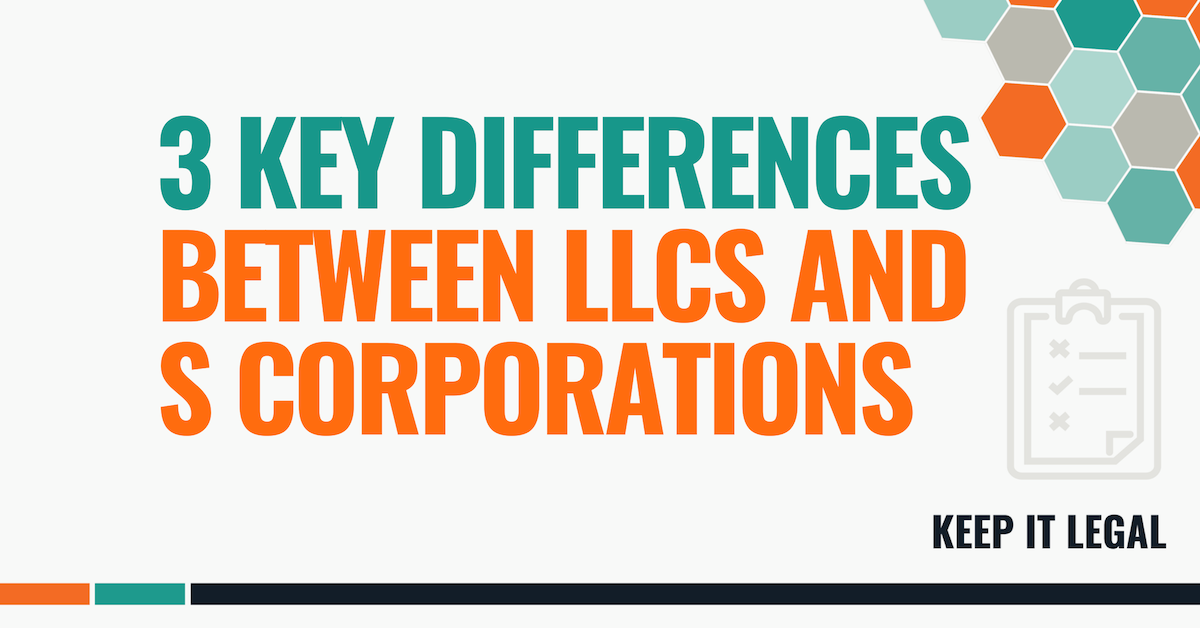New business owners often get confused when it comes to the differences between LLCs and S Corporations. In truth, the entities are similar in many ways. Both are designed to shield the individual owners from liabilities incurred by the entity. This means that in many circumstances, the owners of LLCs or S Corporations cannot be sued personally for the debts of the company. Additionally, both limited liability companies (LLCs) and S Corporations can enter into contracts, incur debts, and initiate lawsuits in their organizational capacity. Note that I’ve chosen to focus solely on S Corps in this article to keep things simple. I’ll tackle C Corporations in another article soon!
There are subtle differences between LLCs and S Corporations in the state of California that every entrepreneur should consider when setting up a new business. This article discusses the three key differences between the two. In many cases, it comes down to differing terminology.
What is an S Corporation?
First things first: what is an S Corporation? In the simplest terms, it is a corporation that has chosen, for federal law purposes, to be taxed under IRS Subchapter S. The state of California will treat the business as an S Corp for state taxation purposes if that is how the corporation has registered federally. An S Corporation does not pay federal income tax; instead, the profits or losses of the S Corporation flow through to the shareholders, who are expected to pay taxes on their share of the business assets (income, deductions, and credits). An S Corp differs from a LLC in three main ways.
Difference #1: Ownership
Limited liability companies are owned by members. The main difference here is in labels. LLC owners are called “members”; their ownership percentages must (logically) add up to 100. LLC ownership interests are typically referred to as “units” or “membership interests.” Like S Corps, these interests can be based on capital contributions, sweat equity, or any other factor the owners agree upon.
S Corporations are owned by shareholders. Owners of S Corps are called “shareholders.” An individual’s percentage of ownership is determined purely by the number of shares he or she owns. S Corps can only have a maximum of 100 shareholders who all hold a singular class of shares.
Difference #2: Privacy & Reporting Requirements
Generally speaking, both LLCs and S Corporations are required to file two important documents with California’s Secretary of State: (1) Articles; and (2) Statements of Information. While these differences between LLCs and S Corporations are subtle, they’re important.
- When an LLC is formed, it must file Articles of Organization.
- When an S Corporation is formed, it must file Articles of Incorporation.
Both documents require disclosure of minimal information, which includes the business name, the purpose of the business, and the contact information of the agent for “service of process” (i.e., a designated individual or entity who agrees to accept service of lawsuits and other official documentation on the corporation’s behalf). Importantly, neither document has to reveal the identity of members or shareholders.
Statements of Information are ongoing reporting requirements, with different required frequencies for each entity:
- LLCs must file Statements of Information every two years.
- S Corporations must file Statements of Information every year.
There’s a significant difference in the amount of information required from LLCs and S Corporations on these statements. Corporate statements must disclose the identities of directors and board members, offering less privacy to stakeholders. An LLC isn’t required to publicly disclose its officers or manager (unless it’s manager-managed, in which case only the appointed manager’s identity must be disclosed). This affords LLCs a much greater amount of privacy with respect to who is in control of the business.
Difference #3: Formalities
S Corporations are legally required to follow certain “corporate formalities,” including: (1) holding meetings between shareholders and the board of directors; and (2) required documentation and organization of meeting minutes in corporate minute books.
LLCs aren’t legally bound to adhere to these formalities. Meetings are not required, and, consequently, neither are meeting minutes. Being able to avoid these formalities can create substantial time and cost efficiencies for LLCs.
Clarifying Differences Between LLCs and S Corporations
While the differences between LLCs and S Corporations are nuanced, I’ve clarified the top three you should be aware of in the state of California. For help setting up your next business, contact me today. I’d be happy to guide you through the process.


